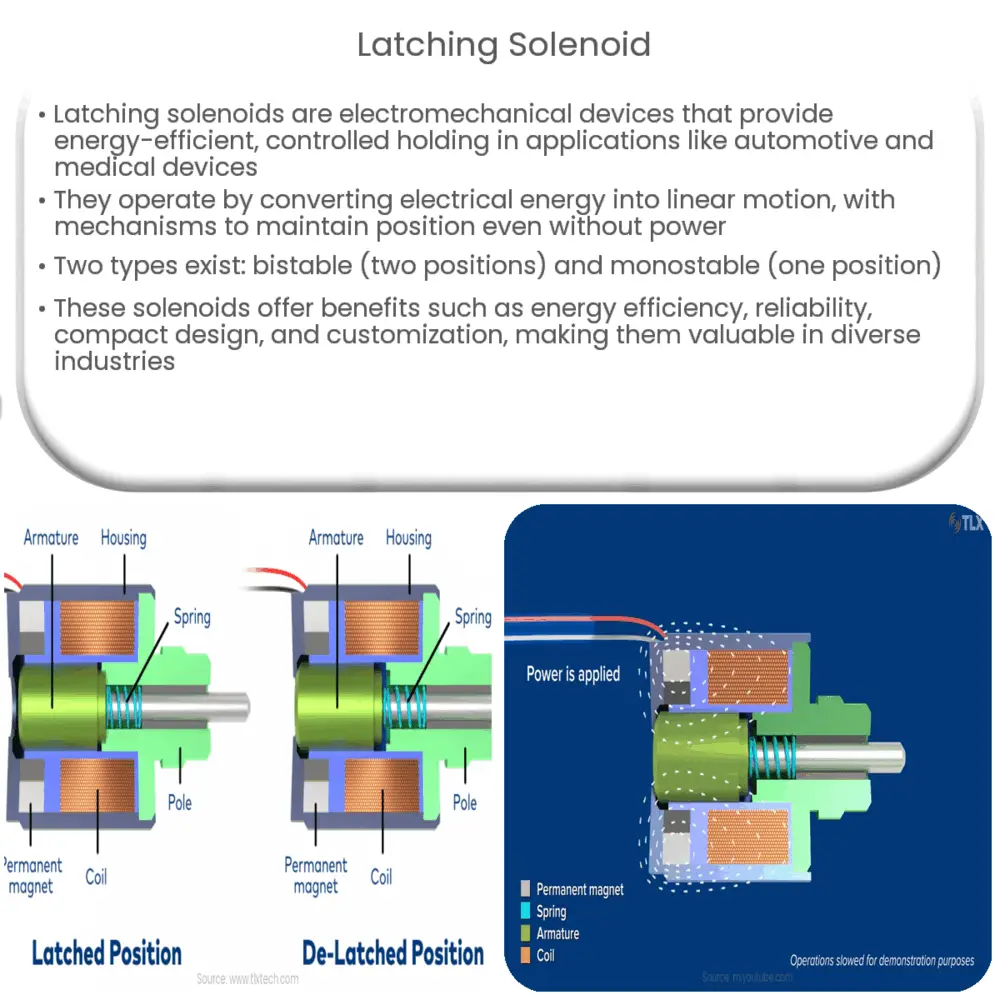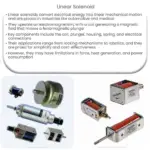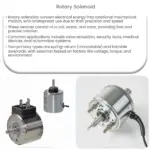A latching solenoid is an energy-efficient, electromechanical device providing controlled linear motion for applications in automotive, aerospace, medical, and security industries.

Latching Solenoid: An Overview
Introduction
A latching solenoid is an electromechanical device that combines the principles of solenoids and latching mechanisms to provide a controlled, energy-efficient means for holding a position in a wide range of applications. Latching solenoids are commonly used in industries such as automotive, aerospace, medical devices, and security systems. This article will provide a comprehensive overview of latching solenoids, including their operating principles, advantages, and common applications.
Operating Principle
A solenoid is an electromagnetic device that converts electrical energy into linear mechanical motion. It consists of a coil of wire wrapped around a metallic core, known as the plunger. When an electric current flows through the coil, a magnetic field is generated, which attracts the plunger, causing it to move in a linear motion. A latching solenoid incorporates a mechanical latching mechanism that allows the plunger to maintain its position even when the power is removed. The latching mechanism can be either bistable (holding two positions) or monostable (holding a single position).
Bistable Latching Solenoid
In a bistable latching solenoid, the plunger can hold two positions: the extended (latched) position and the retracted (unlatched) position. An external force or a pulse of electrical energy is required to change the position of the plunger. Once the plunger reaches the desired position, the latching mechanism holds it in place without consuming any power. To reverse the action, an opposite electrical pulse or force is applied, causing the plunger to move back to its original position. Bistable latching solenoids are highly energy-efficient, as they require power only during the brief periods of state change.
Monostable Latching Solenoid
A monostable latching solenoid is designed to hold only one position, typically the extended position. When power is applied to the coil, the plunger moves to the extended position and is held in place by the latching mechanism. When power is removed, the plunger returns to its original position due to the presence of a spring or an external force. Monostable latching solenoids are ideal for applications that require a fail-safe mode, as they automatically return to their original position when power is lost.
Advantages of Latching Solenoids
Latching solenoids offer several key advantages over traditional solenoids. Some of the most notable benefits include:
- Energy efficiency: Latching solenoids consume power only during state changes, making them suitable for battery-powered and energy-sensitive applications.
- Reliability: The mechanical latching mechanism ensures that the plunger remains in the desired position even in the event of a power loss or system failure.
- Compact design: Latching solenoids can be designed to fit into tight spaces, making them ideal for a variety of applications where space is limited.
- Customization: Latching solenoids can be tailored to meet the specific needs of various applications, including variations in voltage, force, stroke, and mounting options.
Common Applications of Latching Solenoids
Latching solenoids are utilized in a wide range of industries and applications, including:
- Automotive: Latching solenoids are used in various automotive systems, such as door locks, seatbelt tensioners, and fuel injector control.
- Aerospace: In aerospace applications, latching solenoids can be found in satellite antenna positioning systems, aircraft landing gear, and valve control systems.
- Medical Devices: Latching solenoids are employed in medical equipment such as ventilators, infusion pumps, and surgical instruments for precise control and minimal power consumption.
- Security Systems: Latching solenoids are used in access control systems, including door locks, electronic safes, and security gates, providing reliable and energy-efficient operation.
- Industrial Automation: Latching solenoids are used in various industrial automation systems for tasks like valve actuation, robotic grippers, and conveyor control.
Selecting the Right Latching Solenoid
When choosing a latching solenoid for a specific application, it is crucial to consider several factors, including:
- Force and Stroke: Determine the required force and stroke length for the application to ensure the latching solenoid is capable of performing the desired task.
- Power Requirements: Consider the available power supply and the power consumption of the latching solenoid, especially for battery-powered or energy-sensitive applications.
- Operating Environment: Evaluate the operating temperature, humidity, and potential exposure to contaminants, which may impact the performance and lifespan of the latching solenoid.
- Mounting Options: Assess the available space and mounting requirements for the latching solenoid, ensuring a proper fit and secure installation.
Conclusion
Latching solenoids offer an energy-efficient and reliable solution for a variety of applications that require precise linear motion control. By understanding the operating principles, advantages, and applications of latching solenoids, engineers and designers can select the appropriate device for their specific needs. With advancements in technology and an increased focus on energy efficiency, the demand for latching solenoids is expected to grow in the coming years, further expanding their presence across various industries.




